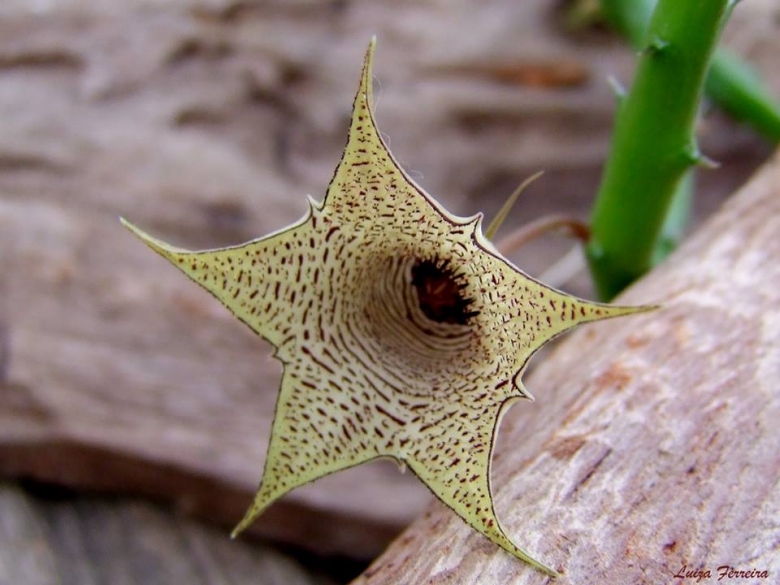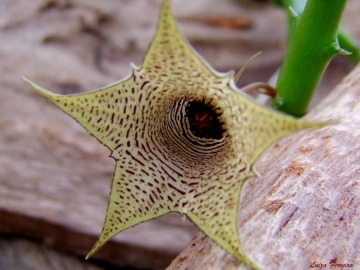




Your support is critical to our success.

Origin and Habitat: South of Vila Pery, Manica Province of Mozambique and possibly also in Central Malawi near Lake Malawi.
Altitude range: Around 800 metres above sea level.
Habitat and ecology: Huernia leachiiSN|30739]]SN|30739]] grows on shallow soil over granite rock and sheer cliffs in the dense shade of overhanging grasses, shrubs and other larger succulents such as Aloes or Euphorbia graniticola, Xerophyta spp or clumps of Coleochloa. The round, prostrate stems are often completely hidden by the plants amongst which it grows.
Synonyms:
- Huernia leachii Lavranos
Description: Huernia leachiiSN|28329]]SN|30739]] is a succulent perennial with thin creeping stems up to 150 cm long forming entangled mats up to two square metres. H. leachii is most closely related to Huernia pendulaSN|30739]]SN|28329]] from the Transkei, but differs in having tooth-like leaves that lasts a long time, larger bell-like flowers with longer pedicels and a concentrically lined pale-coloured corolla with columnar papillae.
Derivation of specific name: Lavranos named this species in honour of Mr L.C. Leach of Salisbury, who committed himself to many years of pains-taking work on the huernias and other stapeliads.
Stems: Procumbent, slender, sometines ascending at the tips, elongated-cylindrical, tapering to a fine point when growing, up to 30 cm long or sometimes longer (to 1.5 m in length), and 5 to 8 mm thick, pale green to reddish, bearing tiny subpersistent tooth-like leaves.
Inflorescences: 1-6-flowered. Flowers developing in succession.
Flowers: Nodding, about 17 mm long and 20-25 mm across. Corolla campanulate its surface cream and densely papillate, pale pinkish-green on the papillate, adorned with broken or continuous concentric maroon or purple lines, with a solid maroon patch at the base of the tube and a purple papillate margin. Outside with 2-5 raised veins running down each lobe. Tube c. 6 mm long, bowl-shaped, slightly pentagonal, without thickening at the mouth. Lobes up to 6 mm long, broadly 3-angular, tapering to a fine point. Corona c. 3.5 mm tall, dark maroon except for the yellow inner lobes.
Fruits: The fruit are paired spindle-shaped capsules (follicles) with the tightly packed seeds inside. At maturity they split open to release numerous small brown seeds crowned with long white hairs.
Bibliography: Major references and further lectures
1) Focke Albers, Ulrich Meve “Illustrated Handbook of Succulent Plants: Asclepiadaceae: Asclepiadaceae” Volume 4 Springer, 2002
2) Doreen Court “Succulent Flora of Southern Africa” CRC Press, 01/June/2000
2) L. C. Leach “A Revision of Huernia R. Br. (Asclepiadaceae)” Aloe, Cactus and Succulent Society of Zimbabwe, 1988
3) Hyde, M.A., Wursten, B.T., Ballings, P., Dondeyne, S. & Coates Palgrave, M. (2015). "Flora of Mozambique: Species information: Huernia leachii."
http://www.mozambiqueflora.com/speciesdata/species.php?species_id=214110, retrieved 10 March 2015

Huernia leachii Photo by: Luiza Ferreira

Huernia leachii Photo by: Luiza Ferreira
Cultivation and Propagation: Huernia leachiiSN|30739]]SN|30739]] produces long thin almost cylindrical stems to 150 cm in length so is most suitably grown in a hanging basket. It grow well in light gritty soil with a very liberal drainage. They should at all times sparingly watered (best rain water with some occasional fertiliser), and in winter time they hardly require any. They require outdoor culture, or a warm close greenhouse, while growing in the early part of summer, and afterwards may be ripened and kept in a greenhouse; but as they bloom chiefly in autumn, warmth is desirable to enable them to expand their flowers. They are also most attractive in a hanging pot with their trailing segments With numerous fleshy (non-hurtful) teeth. Some collectors enjoy the long, snake-like stems induced by an excess of water.
Spring: When winter ends and they begin to grow again, they will require much water and soaking the pots will no longer put the plants at risk for rot. In the spring they will grow well in partial shade and leaving them out in the rain may provide them with the water they need.
Summer: In the summer months they will tolerate heavy rain, but will be just as happy if the season is dry. It's best to sort out the stems while the plants are resting in the summer before they begin their autumnal growth cycle. They will tolerate very hot weather outdoors as long as they are kept in filtered light and this will encourage them to flower in the Autumn. They also enjoy some fertiliser. Moving the plants as they are developing buds may cause them to spontaneously abort the flowers all together.
Autumn: In the fall keep them outdoors until the night time temperatures drop below the 5°C.
Winter: Winter care presents no problems at 5°-10° C with plenty of light. As soon as they are flowered be sure to take extra precautions to keep them dry, because damp cool conditions when the plants are resting is an invitation to fungal infections, but - according to temperatures –some occasional lit watering may be useful.
Potting medium: Since roots are quite shallow, use a cactus mix or add extra perlite or pumice to regular soil potting soil. A gritty, very free-draining compost is suitable, and clay pots help the plants to dry out between watering. Re-pot every 2 years.
Pest and diseases: Huernias are generally fairly easy to grow, especially if kept pest-free. They are very susceptible to stem and root mealy bugs, and damage from these may well initiate fungal attack. Any time when there is a dead or dying stem in the pot it is important to remove it immediately and completely before other healthy stems can become ill too, isolate the healthy parts, dry them off, and re-root them in new compost.
Propagation: Easiest with stem cuttings. Allow cuttings to dry a day before planting. Stems must be laid (Not buried) on gritty compost and will then root from the underside of the stems. It can also be increased from seeds sowing in spring in moist, sandy peat moss. Barely cover seeds. Seeds germinate quickly. In any season it's best to lay the stems out for several days before replanting them and then pot them only in dry soil and withhold any water until they begin to shrivel or start growing again.
| Your Actions | |
|---|---|
| Back to Huernia index | |
| Back to Asclepiadaceae index | |
 |
Back to Succulents Encyclopedia index |
Privacy stantement - Terms and conditions - How to cite - About us - Feedback - Donate



